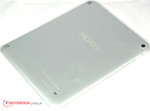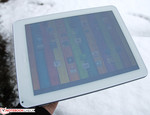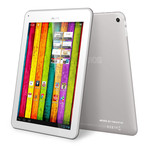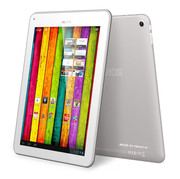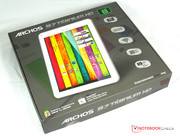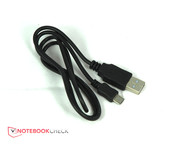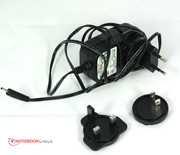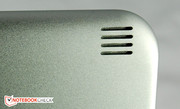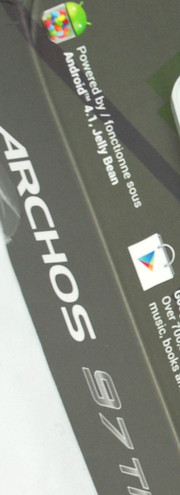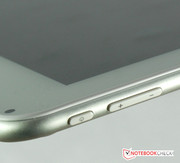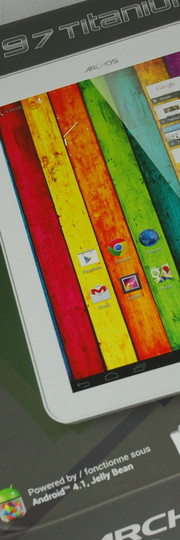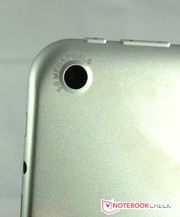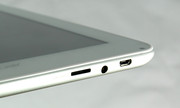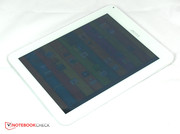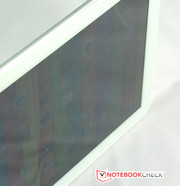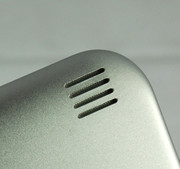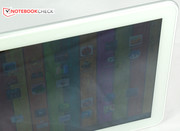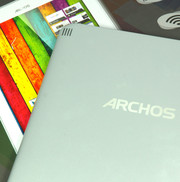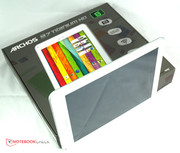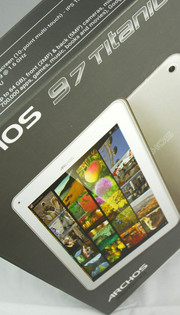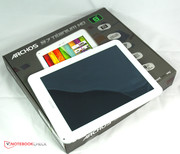Review Archos 97 Titanium HD Tablet

For the original German review, see here.
There's no question that the slim tablet from France looks good. Its capacitive screen has a size of 9.7 inches and makes use of the IPS technology at a resolution of up to 2048x1536 pixels. That sounds promising. However, our review reveals whether the screen really comes as close to the equally sized Retina display in the iPad 4 as it wants to make the user believe. A dual-core A9 processor with a clock speed of 1.6 GHz from Rockchip beats in the 97 Titanium HD's aluminum chest, just like in the smaller 8-inch Titanium brother. The device sports an 8 GB internal memory, which is scanty even for this price range. A GPU in the form of Mali 400 MP4 is responsible for the graphics. According to the manufacturer's specs, the tablet promises a lot of processor power and fun with the latest 3D games owing to a quad-core graphics processor. We examined whether this works in HD mode which can be optionally selected in the screen settings, or whether the performance caves in when the computational demand is increased. Archos demands a price of approximately 260 Euros (~$348) for the tablet based on the Android 4.1 Jelly Bean operating system. This sounds like an inexpensive alternative to the Retina tablet from Cupertino. We checked whether the customer really finds a bargain when opting for the Apple duplicate made in France or whether it is ultimately just hot air.
Case
The tablet is well-built. This starts with an "oh-la-la" for the plain white bezel and a continuous glass surface that seamlessly reaches to the edges of the 9 x 240 x 184 millimeter (~0.35 x 9.45 x 7.24 inches) casing and which is framed by a white plastic bezel. It is very discreet and ensures that neither spines nor sharp edges unpleasantly mar the feel when handling. Even the back of the good-looking French device is "wow". The entire tray is made of matte, brushed aluminum. If it weren't for Archos' logo engraved on the back, the device could easily be mistaken for the product of a famous Californian tablet from a distance. We can only guess what Apple thinks of the iPad twin. In any case, the chassis features a model figure with a weight of 640 grams (~1.41 pounds) and a thickness of 9 millimeter (~0.35 inches). In comparison with that, the iPad 4 weighs a bit more with 652 grams (~1.44 pounds) and is a bit thicker with 9.4 millimeters (~0.37 inches).
The shape, color and workmanship doubtlessly make the Archos 97 Titanium HD an eye-catcher. The handling experience of the tablet is also pleasing. Rounded plastic edges and the brushed metal surface make it pleasant to hold. The flat, sleek chassis really feels good in the hands. The casing's stability does not come up short. The aluminum back is quite rigid and defies any warping attempts quite well. A minor point deduction is made because the screen responds with clouding and streaks where selective pressure is applied with a fingertip on the casing's rear.
Connectivity
The available interfaces implemented in Archos' 97 Titanium HD are neither particularly diverse nor innovative. To make it short, only the essentials are installed. The device sports one micro USB 2.0 port, one 3.5 millimeter audio jack for connecting headphones, for example, and one microSD slot for expanding the memory up to 64 GB.
Software
Archos' 97 Titanium HD is based on the quite new Android 4.1 version, aka Jelly Bean. Unlimited access to Google's Play Store is granted. A few apps are preinstalled on the device. Among them "OfficeSuite Viewer" for reading MS Office documents and "Brief Me", which groups Facebook, Twitter and news feeds.
Communication & GPS
The tablet supports Wi-Fi in the 802.11 b/g/n standards. Data sharing via Bluetooth is not featured. The tablet neither sports an integrated modem for Internet connections on the move nor will the user find a GPS module.
Cameras & Multimedia
Archos' 97 Titanium HD is quite suitable as a tablet camera owing to the front-facing camera's resolution of 2 megapixels and 5 megapixel rear-facing camera. Of course, the key question remains: why does a tablet need a camera and what is expected from it? The pictures are usually less than good in most cases and the 97 Titanium HD is no exception. But the tablet includes cameras and they are suitable for the occasional snapshot. The rear-facing camera's results are acceptable. The colors are not exceptionally brilliant but fairly focused, so the pictures don't look at all bad. And the front-facing camera is quite suitable as an "animated" pocket mirror besides its actual purpose, for example video chats. The result is a bit off-centered; the colors need getting used to and are unfocused. However, we can speak of overall solid camera equipment.
Accessories
Besides a user's manual, we found a power supply unit with three different plugs for use abroad in the box. A USB cord is also included. Archos offers optional accessories, such as a stylus for inputting on capacitive screens for 14.99 Euros (~$20), in its online shop.
Warranty
As to the warranty, Archos states that it complies with the statutory warranty, which equals 24 months in Germany. The retailer is the point of contact for the customer in such cases.
Input Devices & Controls
As pleasing as the very good-looking tablet has proved to be so far, it soon becomes clear that “all that glitters is not gold” when using it for the first time. However, we will first look at what works well. We have nothing to reproach about the sensitivity and precision of the 9.7-inch capacitive, 10 point multi-touchscreen with IPS technology. The inputs are implemented quite well. Controlling and selecting the virtual keys is precise. Scrolling and swiping also works perfectly. Internet surfing or opening and closing several tabs is no problem for the screen either. So far, so good.
But now for the big "but". As mentioned in the intro, the tablet features HD mode that can be selected in the screen settings. It is no question that the user will want to use this mode since this option is one of the main reasons to purchase the 97 Titanium HD. Not every tablet can boast having an HD screen. So those who opt for Archos' HD device will be looking forward to just this: crisp, razor-sharp pictures in HD quality, which give games or movies a very special visual pleasure. However, this is nothing but false hopes in the case of our test device. For example, regrettably games refuse to run in HD quality. Everything is all right when the tablet is running in HD mode as long as no application is opened. Otherwise, the user will be astonished when trying to do something as harmless as browsing through Google's Play Store. Using the search function causes the screen to suddenly flicker and it does not stop even after several attempts, as can be seen in our video. The same is observed when we performed graphics benchmarks. Flickering and dithering everywhere we looked. The screen could not even render the undemanding game Angry Birds smoothly. A firmware update executed during the tests did not remedy this either. We will shortly receive a second test device from the manufacturer and check the display issues again. We will expand and update our tests according to any new findings.
Display
When the manufacturer writes HD on the box, it should be able to live up to this statement. We just described that Archos' 97 Titanium HD exhibits flaws in terms of HD capability. However, we also looked at the screen's brightness disregarding its pixel density and flicker sprees. Using Gossen Mavo Monitor, we measured the 9.7-inch screen's luminance at nine points and ascertained a maximum brightness rate of 193 cd/m². The screen's weakest area is the lower right with 171 cd/m². Like Archos' tablet, the iPad 4 also features a screen size of 9.7 inches with a resolution of 2048x1536 pixels. In contrast to the good-looking French device, the Californian tablet's maximum brightness of 327 cd/m² is compelling. That lets the tablet from Archos look a bit pale. However, that naturally has its price. The iPad 4 costs around 600 Euros (~$802) while Archos' 97 Titanium HD is available for less than half of that. However, other tablets that are less expensive than the iPad 4 offer brighter screens. An example would be Google's Nexus 10 that is even brighter with a maximum of 419 cd/m² and which costs roughly 100 Euros (~$134) less than the iPad 4. Prestigio's MultiPad 7.0 is brighter than Archos' 97 Titanium HD. It reaches a maximum of 306 cd/m² and it is even cheaper than the Archos tablet with a price of around 150 Euros (~$200).
| |||||||||||||||||||||||||
Brightness Distribution: 88 %
Center on Battery: 183 cd/m²
Contrast: 704:1 (Black: 0.26 cd/m²)
Seen subjectively, the screen's brightness is acceptable despite the mediocre brightness rates. This could be related to the decent black value of 0.26 cd/m². The colors look saturated and bright. The contrasts are sharp. The screen does a good job when the picture does not flicker.
Tablets featuring a low to medium screen brightness have a hard time outdoors. Archos' 97 Titanium is no exception. As pretty as it shines at the desk, it is only half as nice to look at outdoors. In other words, it is very difficult to see anything or recognize displayed content on the screen with ease. The glossy screen contributes to that. The screen's performance did not completely convince us outdoors. However, this is an expectation that many tablets only fulfill to an extent due to their reflective surface alongside a low brightness.
As to the screen's viewing angle stability, it is very dependent on the environmental conditions. An acceptable picture quality in even very acute angles is observed indoors. However, the screen's possibilities are soon exhausted outdoors and the user looks upon an empty-looking, reflective surface.
Performance
We sent Archos' 97 Titanium HD, configured with a dual-core A9 processor model Rockchip RK 3066, 1.6 GHz and a Mali 400 MP4 graphics chip, through our virtual benchmark course. The first benchmark we performed was a performance check via Androbench 3. Compared with Bullman's Tab 9 AQQ Revolution and Bullman's Tab 9 AD Revolution, the Archos device is particularly impressive in the sequential read and random write parts. On the other hand, the otherwise decently manufactured tablet looks rather weak in contrast to Bullman's Tab 9 AQQ Revolution in the synthetic Antutu Benchmark V3. The 97 Titanium HD only managed 9847 points while Bullman's Tab 9 AQQ did much better with 16155 points. The Antutu benchmark score is even poorer in HD mode. Archos' tablet only achieved 9452 points, which are approximately 400 less than in normal mode. It is similar in Geekbench 2 which also assesses the CPU and GPU performance. Archos' device is the back marker with 1011 points here. The tablets from Apple or Bullman are simply better in a direct comparison.
| AnTuTu v3 | |
| I/O (sort by value) | |
| Archos 97 Titanium HD | |
| Archos 97 Titanium HD | |
| Bullman Tab 9 AQQ Revolution | |
| RAM (sort by value) | |
| Archos 97 Titanium HD | |
| Archos 97 Titanium HD | |
| Bullman Tab 9 AQQ Revolution | |
| GPU (sort by value) | |
| Archos 97 Titanium HD | |
| Archos 97 Titanium HD | |
| Bullman Tab 9 AQQ Revolution | |
| CPU (sort by value) | |
| Archos 97 Titanium HD | |
| Archos 97 Titanium HD | |
| Bullman Tab 9 AQQ Revolution | |
| Total Score (sort by value) | |
| Archos 97 Titanium HD | |
| Archos 97 Titanium HD | |
| Bullman Tab 9 AQQ Revolution | |
| Geekbench 2 - 32 Bit - Total Score (sort by value) | |
| Archos 97 Titanium HD | |
| Apple iPad 4 | |
| Bullman Tab 9 AQQ Revolution | |
| Trekstor Surftab Ventos 9.7 | |
| Bullman TAB 9 AD Revolution | |
| AndroBench 3-5 | |
| Random Write 4KB (sort by value) | |
| Archos 97 Titanium HD | |
| Bullman Tab 9 AQQ Revolution | |
| Bullman TAB 9 AD Revolution | |
| Random Read 4KB (sort by value) | |
| Archos 97 Titanium HD | |
| Bullman Tab 9 AQQ Revolution | |
| Bullman TAB 9 AD Revolution | |
| Sequential Write 256KB (sort by value) | |
| Archos 97 Titanium HD | |
| Bullman Tab 9 AQQ Revolution | |
| Bullman TAB 9 AD Revolution | |
| Sequential Read 256KB (sort by value) | |
| Archos 97 Titanium HD | |
| Bullman Tab 9 AQQ Revolution | |
| Bullman TAB 9 AD Revolution | |
We wanted to check the true HD graphics capability of Archos' 97 Titanium HD using the GL Benchmark. Regrettably, this couldn’t be done. At least in this benchmark since the device refused to run the test in HD mode. We first noticed the usual flickering and shimmering before it suddenly crashed. A second attempt without HD, i.e. normal mode, worked. However, the result was downright devastating compared with Apple's iPad 4. In the NenaMark 2 graphics test, the tablet achieved 56.9 fps in normal mode and a mere 39.9 fps in HD mode. This is a clear performance decrease when the mode is changed.
| GLBenchmark 2.5 | |
| 1920x1080 Egypt HD Offscreen Fixed Time (sort by value) | |
| Archos 97 Titanium HD | |
| Apple iPad 4 | |
| Bullman Tab 9 AQQ Revolution | |
| Egypt HD Fixed Time (sort by value) | |
| Archos 97 Titanium HD | |
| Apple iPad 4 | |
| Bullman Tab 9 AQQ Revolution | |
| NenaMark2 - --- (sort by value) | |
| Archos 97 Titanium HD | |
| Bullman Tab 9 AQQ Revolution | |
Archos' tablet managed 1837 points in Google's V8 browser-based benchmark and even marginally surpasses the 1661 points of Apple's iPad 4.
| Google V8 Ver. 7 - Google V8 Ver. 7 Score (sort by value) | |
| Archos 97 Titanium HD | |
| Apple iPad 4 | |
| Bullman Tab 9 AQQ Revolution | |
| Trekstor Surftab Ventos 9.7 | |
The 97 Titanium HD achieved 1195.9 ms in the Javascript benchmark Sunspider. However, lower is better in this case. Consequently, Apple's iPad 4 clearly has the lead with 895.3 ms in this test.
| Sunspider - 0.9.1 Total Score (sort by value) | |
| Archos 97 Titanium HD | |
| Apple iPad 4 | |
| Bullman Tab 9 AQQ Revolution | |
| Trekstor Surftab Ventos 9.7 | |
* ... smaller is better
Games
Archos' 97 Titanium generally had a hard time with games in HD mode. The car racing game Need for Speed - Hot Pursuit did not even start. The more undemanding game Angry Birds could not be played either. As mentioned earlier, the representation issues in HD mode where the screen permanently flickers and dithers thwarts smooth game play. Angry Birds could be played fairly smoothly in normal mode. Another surprise awaited us in the car racing game Raging Thunder 2. Besides the dithering and flickering of the screen in normal mode, we also experienced problems with steering. The position sensor swapped left and right. It is possible that this issue only concerns the game Raging Thunder 2. Nevertheless, the tablet is generally not recommendable as a gaming tablet. There are simply too many ifs and buts and the lack of HD capability really spoils the fun.
Emissions
Temperature
Archos’ 97 Titanium HD did not exhibit a significant temperature increase even under stress. The temperature increased to a maximum of 34.5 degrees Celsius (94.1 Fahrenheit) on the front center edge during the Stability test. The tablet constantly remained below 30 degrees Celsius (86.0 Fahrenheit) at all 18 measuring points, i.e. nine on the device's front and nine on the back, in idle mode. The thermometer recorded 29.9 degrees Celsius (85.82 Fahrenheit) at the warmest spot. Consequently it is possible to use the tablet on the lap without hesitation. The power supply unit reached a load temperature of 40.1 degrees Celsius (104.18 Fahrenheit) and an idle temperature of 32.5 degrees Celsius (90.5 Fahrenheit). Thus, we cannot complain about the temperatures of Archos' tablet.
(+) The maximum temperature on the upper side is 34.5 °C / 94 F, compared to the average of 33.7 °C / 93 F, ranging from 20.7 to 53.2 °C for the class Tablet.
(+) The bottom heats up to a maximum of 32.8 °C / 91 F, compared to the average of 33.2 °C / 92 F
(+) In idle usage, the average temperature for the upper side is 27.8 °C / 82 F, compared to the device average of 30 °C / 86 F.
Speakers
Much poorer tablet sound-generators exist than the stereo speakers installed in Archos' 97 Titanium HD. Although mids, trebles and bass are not very differentiated, the slightly tinny sound is quite rich for a tablet. Users who want to enjoy music should however use a headphone.
Energy Management
Power Consumption
Archos' 9.7-inch tablet consumed 4.1 Watts when idling with minimum brightness and disabled Wi-Fi. The tablet made in France devoured a whole 8.1 Watts with maximum brightness, enabled Wi-Fi and high-performance mode. Comparable devices, such as Bullman's Tab 9 AQQ, managed with a good 4 Watts less in this scenario. The device guzzled 8.3 Watts during full processor load and even 11.6 Watts in the CPU + GPU Stability test, which is quite high. Bullman's tablet consumes a maximum of 8.9 Watts here.
| Off / Standby | |
| Idle | |
| Load |
|
Key:
min: | |
Battery Runtime
The manufacturer does not specify the capacity of the lithium-polymer battery built into the 97 Titanium HD. Therefore we will look at the facts in the form of the real battery runtimes. The battery in Archos' tablet lasted for 10 hours and 38 minutes in the read test, using minimum brightness and enabled Wi-Fi. Apple's top of the range iPad 4 managed over 20 hours here. The practical Wi-Fi test with the brightness set to 150 cd/m² finished after around 6 hours. Bullman's Tab 9 AQQ only managed 5 hours and 48 minutes before it needed the outlet. CPU + GPU full load via the Stability test was finished after 3 hours and 47 minutes. Archos' tablet is roughly on a par with Bullman's 9.7-inch tablet in this case.
Verdict
"HD is on it, but not in it". This might describe the sobering impression that Archos' 97 Titanium HD made in our tests. Of course, the tablet is a real eye-catcher. It is slim, well-built and the aluminum chassis makes not only a stylish but a robust impression. And nevertheless, it was not really fun using Archos' 97 Titanium, powered by Android 4.1 Jelly Bean operating system. The nice exterior already starts to crumble when turning on the device for the first time. The 9.7-inch screen with a resolution of 2048x1536 pixels makes a good impression at first glance. The colors are bright, the contrast is agreeably crisp, and the capacitive touchscreen is very responsive. However, the brightness rates could be better. Everything is fine up to this point.
The tragedy begins when the user wants to set up the tablet via, for example, apps from Google's Play Store. Being a proud user of an HD capable tablet, we of course selected the corresponding HD mode only to quickly find out that the screen cannot properly display a simple search in Google's Play Store. It flickers, dithers and nothing works. The tragedy continues when an app or game is ultimately installed from Google's Play Store using the screen's normal mode. Set HD mode on and start the game - only to discover that the screen refuses to work by displaying massive flickering. Not even the undemanding game Angry Birds runs. Downloading the latest firmware did not help here either. We will shortly look closer at a second, identical test model and update the test results accordingly.
To make it short: HD-free would be a good diagnoses for a German Shepherd (free of hip dysplasia). The disappointment is immense in a tablet that explicitly touts the feature "HD", high-definition pictures, but does not supply this experience. Consequently, we cannot give Archos' 97 Titanium HD an unlimited purchase recommendation. Users who are looking forward to motion pictures in high-definition or even "Retina" quality will be disillusioned. The reason that Archos' tablet nevertheless achieves a "good" is due to our rating system that places all devices of a category in relation to each other. Therefore, we devalued the device due to the screen's poor performance via the point "Impression".




